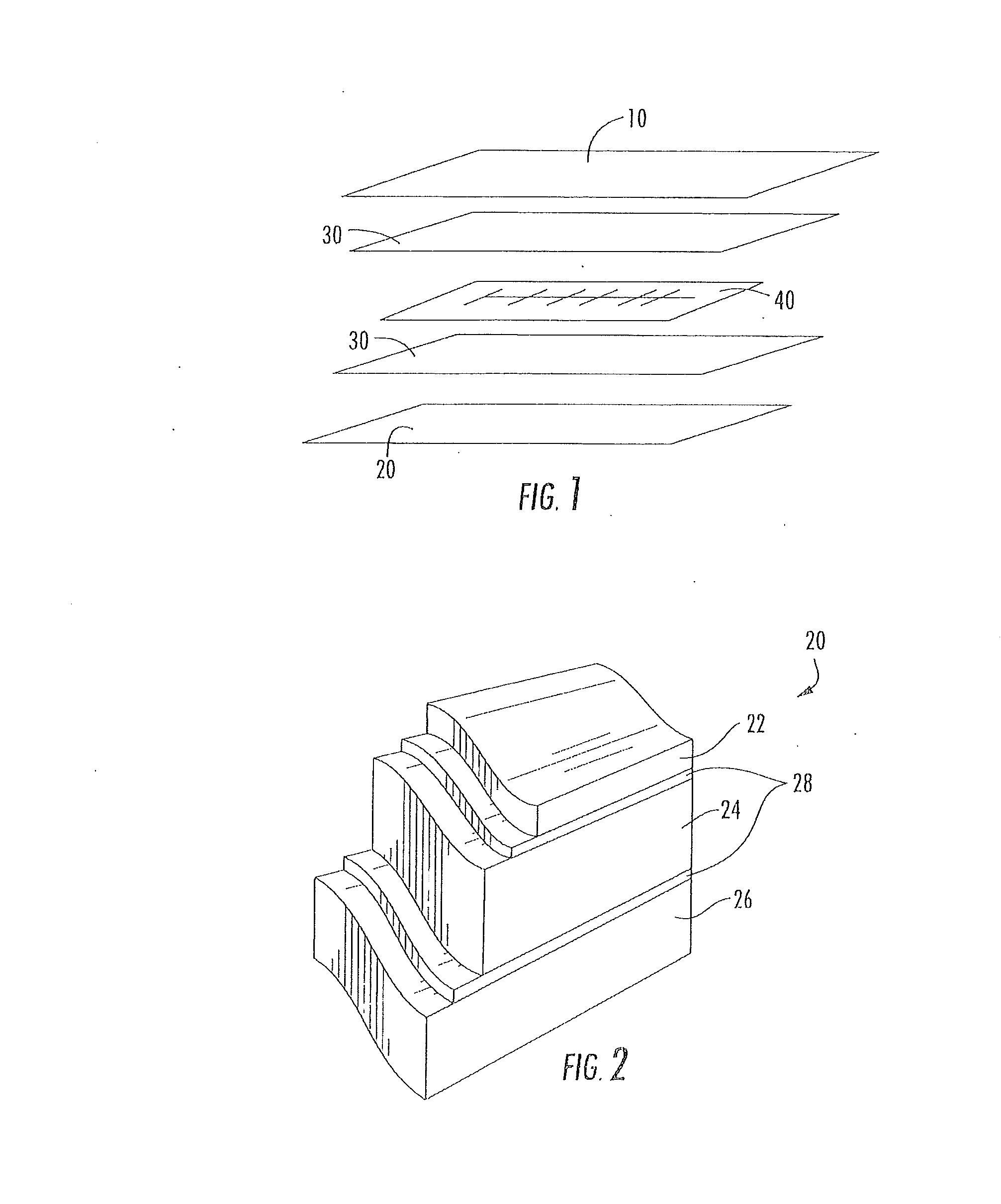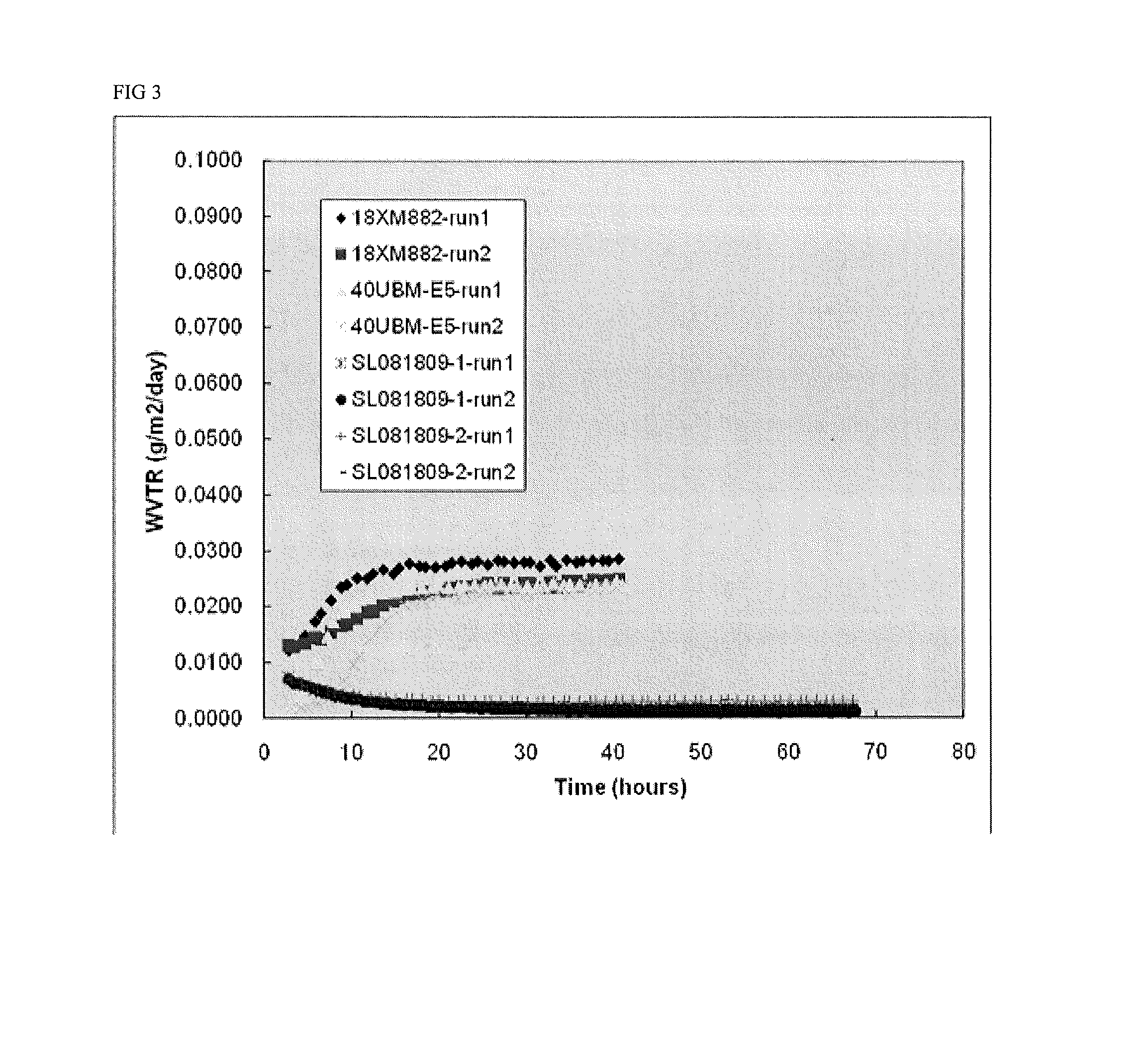High Performance Backsheet for Photovoltaic Applications and Method for Manufacturing the Same
a photovoltaic module and high-performance technology, applied in the field of photovoltaic modules, can solve the problems of high cost of photovoltaic modules, damage to solar cells, and corrosion of underlying parts such as photovoltaic elements, and achieve the effect of high performan
- Summary
- Abstract
- Description
- Claims
- Application Information
AI Technical Summary
Benefits of technology
Problems solved by technology
Method used
Image
Examples
examples
[0041]Laminates incorporating metalized PP (polypropylene) were prepared and tested for Moisture Vapor Transmission Rates. Metalized PP is a metalized (layer of aluminum) polypropylene. Samples were prepared using different grades commercially available from ExxonMobil: 18XM882 and 4OUBM-E5. Samples of the metalized PP and laminates of Protekt / metalized PP / EVA were subjected to MVTR testing at Southern Mississippi University. The laminates had a Protekt® (Lumiflon® based fluorocopolymer coating) layer that is 13 μm thick and an EVA (ethylene vinyl acetate) layer that is 100 μm thick. The manufacturer (ExxonMobil) reports MVTR as 0.02 g / m2 / day. The laminates, however, exhibited MVTR 10 times lower as illustrated in Table 1 below in which SL081809-1 and 2 are different samples of the laminate.
TABLE 1SampleWVTR: g / m2 / daySL081809-10.0014SL081809-20.002618XM8820.026240UBM-E50.0240
[0042]The results over time are displayed in FIG. 3.
[0043]Since MVTR is typically a function of thickness it ...
example 2
[0044]The disadvantage of EVA and other polyolefins is their susceptibility to thermal oxidative degradation. It is especially important for polymeric materials used in PV applications as backsheets. UL 1703 states, RTI (Relative Thermal Index) of backsheet shall be at least 90° C. In addition, the RTI shall not be less than 20° C. above the measured operating temperature of the module. As modules work at higher and higher temperatures, the RTI of 105 C a common rating. When polymer degrades, the products of degradation evolve (outgas) and these products can be detected (quantitatively and qualitatively) by Head Space Gas Chromatograph (HSGC).
[0045]A number of compounded EVA samples were prepared and tested for outgas. The specific products of degradation were not identified but the quantity of volatile material evolving from the polymers after being heated at 155 C for 160-500 hrs was analyzed. Mylar A (a polyester) served as a control. Uncompounded EVA, (EVA without any additives)...
example 3
[0048]The increase in robustness of compounded EVA with respect to i) thermal stability; ii) UV stability is illustrated in the following Examples. The Example films were prepared and evaluated as follows: 1) Control-EVA-2) EVA compounded with R105 TiO2 (DuPont), Cytec Cyasorb® UV—2908 light stabilizer (free radical scavenger hindered benzoate) 0.1% by weight, Cytec Cyanox® 2777 antioxidant 0.1% and R105 TiO2, UVOB Ciba 0.1% by weight. The formulated EVA as described herein can be produced as a film by extrusion, blowing or other means, or can be extruded directly on the substrate, such as, polyolefin, polycarbonate, etc. Laminates were prepared as follows: 1) fluorocopolymer coating (Lumiflon® based) / 5 mil Mylar A / EVA 2) fluorocopolymer / 5 mil Mylar A / EVA 0.1% additives.
[0049]Testing Methods and Results:
[0050]The samples were put through a number of tests to evaluate the properties of the samples.
[0051]Oxygen Induction Time (OIT) Test
[0052]Is a technique for evaluating the oxidative...
PUM
| Property | Measurement | Unit |
|---|---|---|
| thick | aaaaa | aaaaa |
| thick | aaaaa | aaaaa |
| thickness | aaaaa | aaaaa |
Abstract
Description
Claims
Application Information
 Login to View More
Login to View More - R&D
- Intellectual Property
- Life Sciences
- Materials
- Tech Scout
- Unparalleled Data Quality
- Higher Quality Content
- 60% Fewer Hallucinations
Browse by: Latest US Patents, China's latest patents, Technical Efficacy Thesaurus, Application Domain, Technology Topic, Popular Technical Reports.
© 2025 PatSnap. All rights reserved.Legal|Privacy policy|Modern Slavery Act Transparency Statement|Sitemap|About US| Contact US: help@patsnap.com


